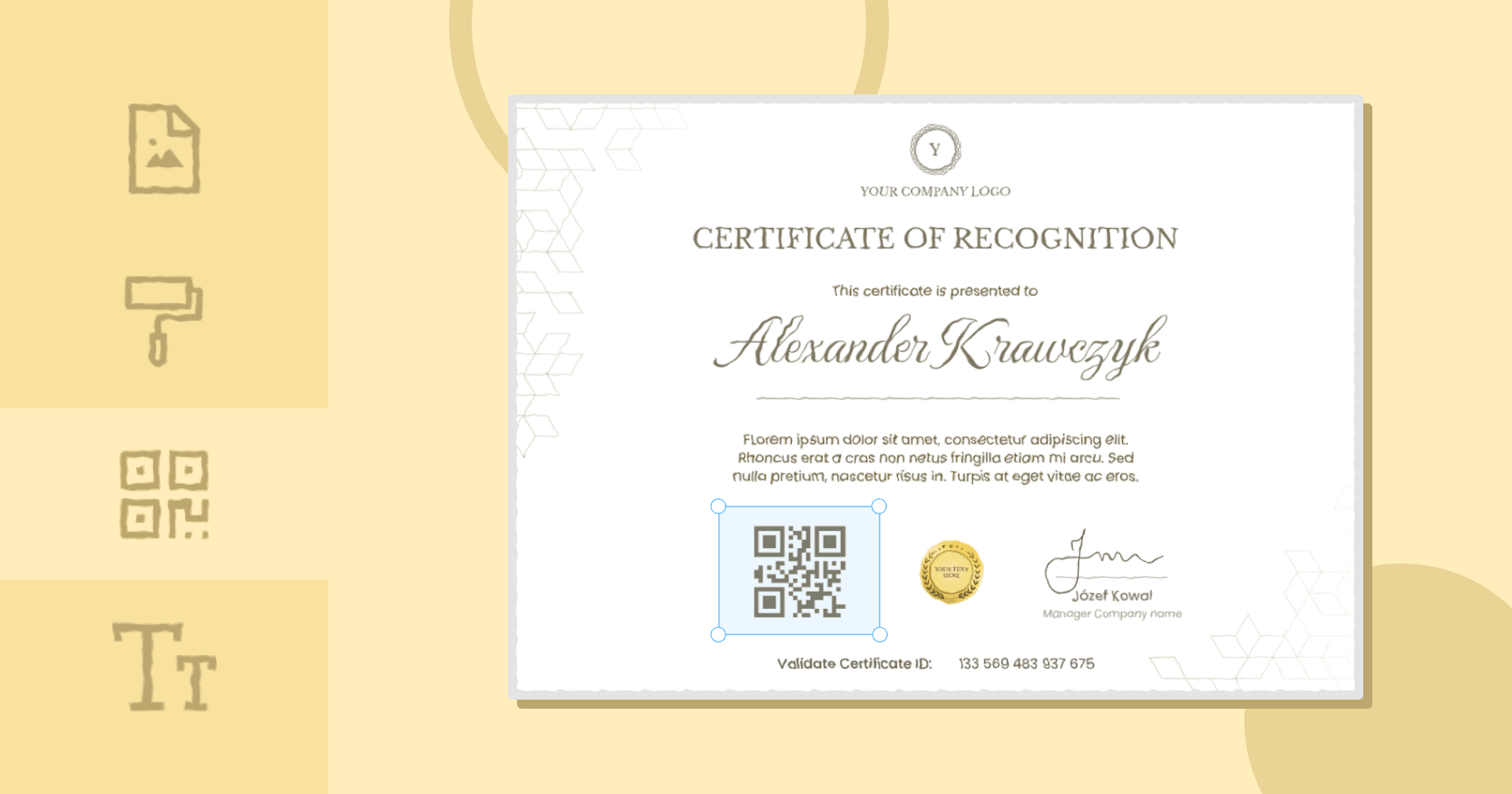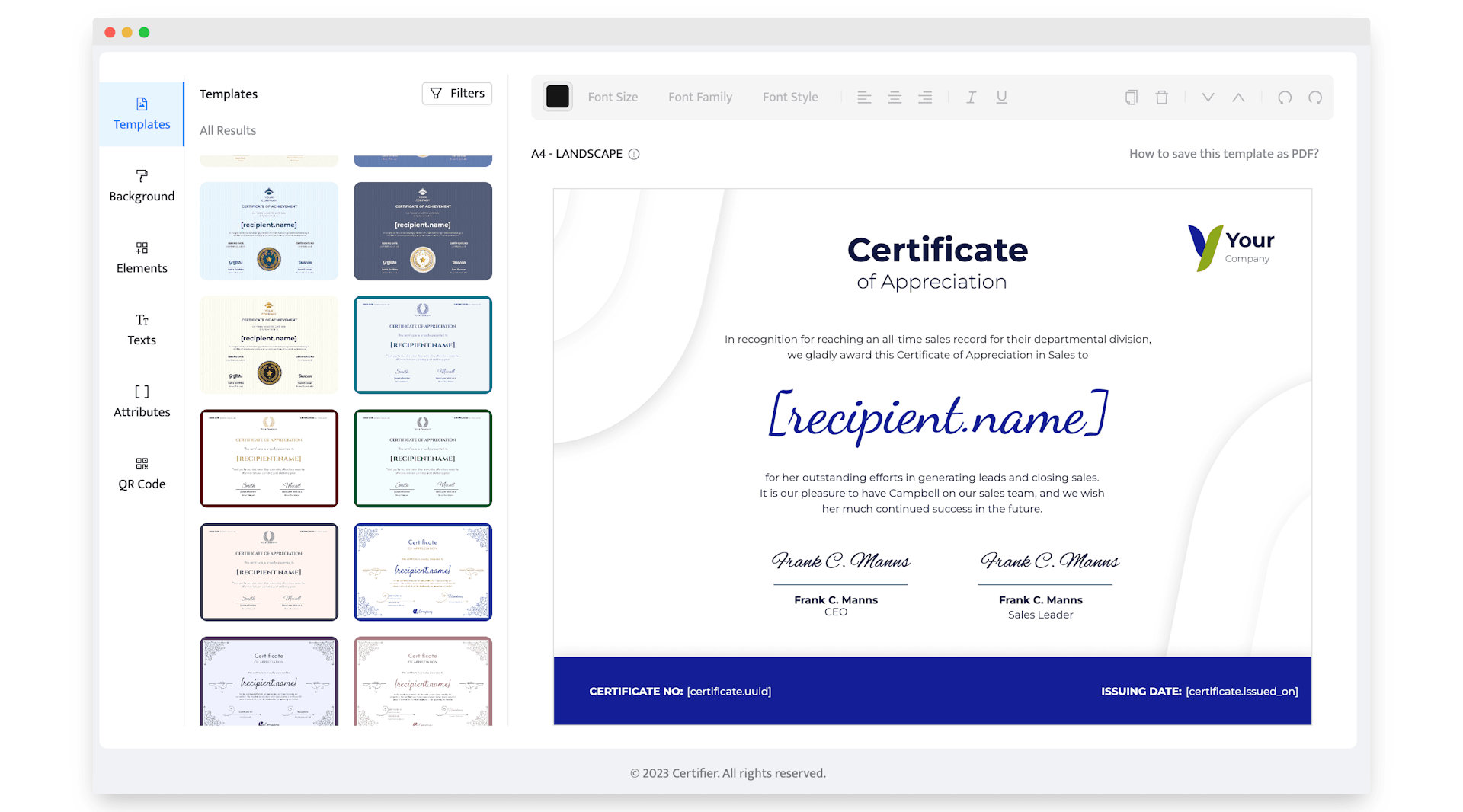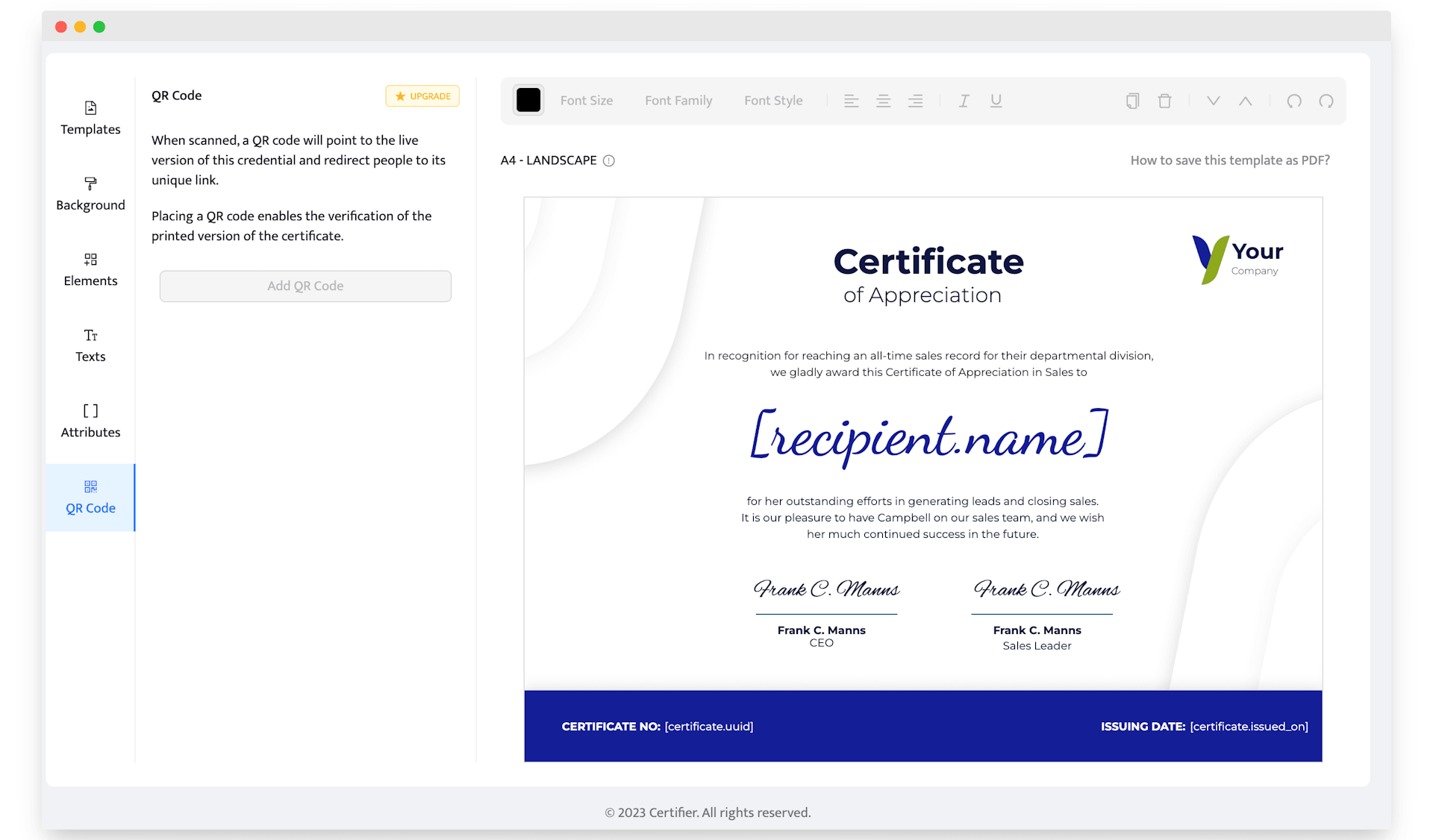Trusted by:
How to Create QR Code for Certificate?
Unleash the power of Certificate QR codes and their benefit to your business. See how to add them in seconds to your certificates (literally!).
AuthorSergey Butko
Updated: April 08, 2024
13 min read

Author
Sergey Butko
Updated: April 08, 2024
13 min read
Trusted by:
Have you ever wished there was an easier way to issue certificates? Have you ever been afraid that someone could try to copy or fake the certificates you issue?
If that's your case, creating a QR code certificate can be an excellent method to secure your documents and give recipients the assurance that their certificate is valid and legitimate. This is only one of the benefits, though.
In this blog post, we'll look at why issuing certificates with QR codes can be a game-changer for your business, what information should be included on your certificate, and how to create QR code for certificate verification in just a few simple steps. Once you wrap up writing, you'll never look back!
What is a QR code certificate?
A certificate QR code is a special type of barcode that can be attached to a certificate or diploma. When scanned, it will provide access to additional information related to the document such as the issuer, date of issue, and other validation data.
Benefits of using QR code certificate verification
Among the real gem benefits of using a QR code certificate are as follows:
Document security and authentication for certificates – with a QR batch on your certificates, you can easily ensure that the documents have not been modified. It also helps you verify the authenticity of each certificate in a matter of seconds.
Easy generation and distribution – QR codes can be created in minutes. It might eliminate the need for manually distributing certificates to recipients almost fully.
Improved customer satisfaction – QR codes provide customers with extra assurance that their certificates are genuine and valid.

How to create QR code for certificate?
Here is the step guide with the quickest and easiest way on how to put QR code in certificate. Check it out and see how simple it is!
Step 1: Generate the certificate
Here comes the design part, where you create the certificate itself. To make sure that your certificates look professional and stylish, use a quality certificate design program to do so. Best if it's an integrated design tool with QR code capabilities. Thanks to that, you don't need to use an external code generator tool (and it's also a much safer option!). The answer? Certifier certificate maker.

Certifier provides an easy-to-use and intuitive drag-and-drop editor that lets you create beautiful certificates in no time! Select a certificate template and design it with a QR code already attached.

Step 2: Create the QR code
Your certificate should include a visible and scannable QR code (for printed and digital versions). All you need to do is enter the URL of your certificate page (if available) or provide any other information you want to be included in your QR code. Then the generators will give you a scannable code that you can embed into your certificate.

Do you want to get to know more about how to create certificates in Certifier? It's pretty easy, check it out: How to Create Custom Certificates – Tips and Tricks.
Step 3: Link the QR code with the data
Once the QR code is generated, you need to link it with some data. When someone scans the QR code, they should be able to access information about your digital certificate – so you can't overlook this step.
You can include any relevant data like course name, instructor details, document issuer information, or issue date in this step. All the data you are linking should be properly stored and encrypted to ensure the highest level of security.
Step 4: Activate the digital certificate and start using it
While creating the digital credential is essential, you need to double-check if it's accessible and secure. For this purpose, use a powerful platform like Certifier which allows you to store certificates in the cloud and share them with others quickly and securely.
Features of certificate QR codes
The modern QR code certificate verification system is more than just a scannable image. It offers secure storage, easy accessibility, and customization options and makes the experience seamless for both – issuers and recipients.
Secure storage and verification
The most important feature that you should look for in a certificate QR code generator is secure storage and verification. This ensures that the codes are stored safely and securely while also allowing you to verify the authenticity of the certificates issued easily. Since they act as digital proof, each security measure is crucial here.
Many open source have either very low-security protocols or no security at all, making them vulnerable to tampering. Choose a secure platform for generating and storing your certificate QR codes – unless you want to deal with potential security breaches and forgeries!
Easy accessibility and sharing
On the other hand, you should also make sure that the platform you choose is easy to use and provides a convenient way for your customers to access their QR code-based certificates. You, as a certificate editor, should also have access to edit and download certificates in case of issues.
You should also be able to easily share the certificate with your customers via a secure link or by email. The more options the platform provides to put codes on certificates, the better.
Customization options for design and layout
When you think of a single QR code, you probably think of a black-and-white pattern. While this is true, many platforms now offer customization options for the design and layout of your QR code.
This means that instead of having to create electronic certificates from scratch every time, you can customize an existing template or design, saving you time and effort in the long run.
Your QR code can be personalized with your own text, logos, images, and even colors. Branding it with your company’s colors and logo is a way to go if you want to increase brand awareness. These customization options also mean that you can create certificates for different purposes.
Validity checks and resubmission requirements
QR codes play a role of authentication and validation when it comes to certificates. Allowing you to check the validity of your certificates easily helps prevent fraud, as well as ensuring that all of the information included in the certificate is accurate.
Your certificates, in default, should come with a validity check and the option to resubmit them in case of any issues. This ensures that your audience is provided with valid certificates and can help you maintain a good reputation for your business.
Database integration for automation
You might also want your platform to be able to integrate with other databases for automation. This allows you to quickly import certificates from existing databases so that you don't need to enter the information every time. While it's not something that's a must-have for most businesses, it can be helpful if you need to manage a large number of certificates.
Digital certificate QR code over traditional certificates
The traditional method of certificate issuance has been tried and true, but as technology advances, so do the expectations.
Speed, efficiency, and cost-effectiveness in verifying credentials
Let's assume that you have to issue 300 certificates to a group of students. If you are using traditional certificates, it might take you long hours (or weeks) to create and send them all out.
Using a QR code, however, takes this time-consuming process down to minutes. You can quickly generate and attach the QR code to each certificate with just a few clicks. There's no need for manual distribution or verification, as the QR code can be used to provide immediate validation of the credentials.
Increased security through data encryption
No more worrying about the security of your certificates or diplomas. With a QR code, you can encode private information such as the date of issue and issuer name into the code, which can't be accessed without scanning it first.
It goes another way, too. A QR code can be used to validate the authenticity of a certificate. When it comes to physical documents, it isn’t easy to tell if they are valid or not, but with a QR code, it’s possible to verify credentials in just seconds.
Improved accessibility for all certificate holders
Whereas traditional certificates are often difficult to access, a QR code offers an easy solution. It can be scanned by anyone with a mobile device and quickly provide the required information about the document to all interested parties.
Easier to track and manage with digital documentation
In this day and age, having digital records of everything is no longer optional. Add a QR code to your certificate or diploma, and you will end up creating an easy-to-track and manage digital documentation system that can be accessed from anywhere with internet access.
Reduced risk of fraudulent activity
Someone completed a certificate course, but the results are in doubt because it's difficult to verify if they are valid or not. With a QR code, you can reduce the risk of fraudulent activity and protect your business from any potential issues caused by fake certificates. And, since it impacts your reputation too, you simply cannot afford not to do it.
Where else certificate QR codes are a good idea?
There are a few industries where certificate QR codes are especially useful. Here are a few examples:
Education: Certificates issued to students, teachers, and other professionals in education can use QR codes to ensure the authenticity of certificates: their diplomas, degrees, accreditations, etc. For example, if you run IT consultancy like Computers in the City, you might want to consider requiring certificates with QR codes from your potential employees.
Banking: Banks and financial institutions can use QR codes to send banking information, such as deposit certificates securely.
Healthcare: Medical facilities, hospitals, and health authority companies can use QR codes to quickly provide access to medical records and health information (e.g., vaccination details, COVID-19 vaccine dose, and recovery certificate, just to name the recent examples).
Online retailers: Online retailers often need to include delivery confirmations or identity verifications with orders. QR codes can make this process easier for both customers and businesses.
Government: Governments around the world rely on certificates as a means of identification for citizens. Using QR codes on certificates makes it easier for governments to share official documents securely.
However, all professional services and businesses can benefit from the use of certificate QR codes.
That's a wrap
Do you need to issue certificates with QR codes? It's not a must-have, but it can certainly be beneficial for everyone involved: from customers to businesses.With Certifier, it's made way easier. We have all the features you need to quickly, securely, and easily manage your certificates. Ready to give it a try?
FAQ

Sergey Butko
Tech entrepreneur. Forbes 30 Under 30 Europe. At Certifier, Sergey’s work focused on revolutionizing the way credentials, certificates, and badges are issued and managed through cutting-edge APIs and software infrastructure.
Sergey Butko
Tech entrepreneur. Forbes 30 Under 30 Europe. At Certifier, Sergey’s work focused on revolutionizing the way credentials, certificates, and badges are issued and managed through cutting-edge APIs and software infrastructure.
Share this article